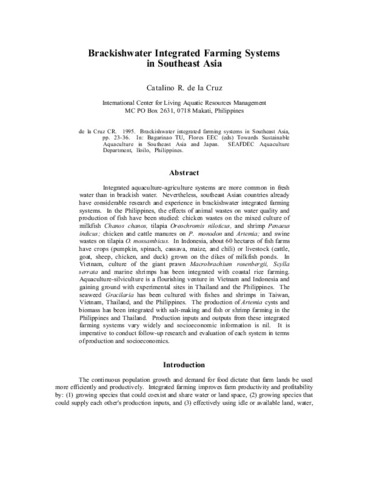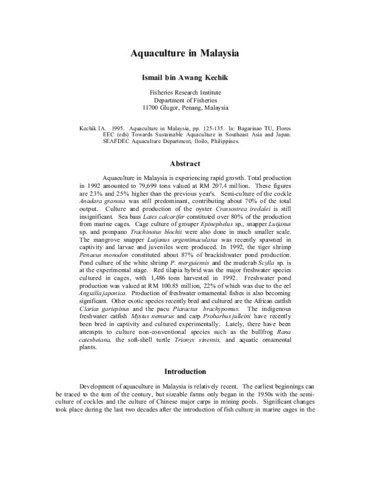Fish nutrition in Thailand: Status and constraints
- Global styles
- MLA
- Vancouver
- Elsevier - Harvard
- APA
- Help

Date
1993Author
Page views
4,750ASFA keyword
AGROVOC keyword
Ctenopharyngodon idella 
Penaeus monodon
Clarias batrachus
Trichogaster pectoralis
Hypophthalmichthys molitrix
Lates calcarifer
Channa striatus
Epinephelus tauvina
Macrobrachium rosenbergii
Oreochromis niloticus
Thailand
Chevron snakehead
Giant perch
Giant river prawn
Giant tiger prawn
grass carp
silver carp
Snake-skinned gourami
Striped snakehead
Walking catfish

Penaeus monodon

Clarias batrachus

Trichogaster pectoralis

Hypophthalmichthys molitrix

Lates calcarifer

Channa striatus

Epinephelus tauvina

Macrobrachium rosenbergii

Oreochromis niloticus

Thailand

Chevron snakehead
Giant perch
Giant river prawn
Giant tiger prawn
grass carp

silver carp

Snake-skinned gourami
Striped snakehead
Walking catfish
Taxonomic term
Metadata
Perlihat publikasi penuh
Share
Abstract
Aquaculture prior to World War II was limited because marine and freshwater fish catches were still abundant. But shortage of fuel and other necessities led to an increase in food prices including fish. The demand for increased fish production in turn increased the number of people involved in fish farming and the number of species cultured to more than 25. The 13 species most commonly cultured include the walking catfish (Clarias batrachus), snakehead (Channa straitus),striped catfish (Pangasius sutchi), gouramy (Trichogaster pectoralis), sand goby (Oxyeleotris marmoratus), grass carp (Ctenopharyngodon idellus), silver carp (Hypopthalmichthys molitrix), bighead carp (Aristichthys nobilis), Nile tilapia (Oreochromis niloticus), freshwater prawn (Macrobrachium rosenbergii), sea bass (Lates calcarifer), grouper (Epinephelus tauvina), and tiger shrimp (Penaeus monodon). Thailand is a major producer of agricultural products in Asia. Large quantities of raw feed materials are produced and consumed each year. Although aquaculture has been in existence as long as land-based agriculture, it has not kept up in terms of feed development. The feeding methods of most cultured fishes are still largely traditional and based on experience using trash fish, rice bran, and broken rice. It was only recently that aquaculture began using feeds to increase production. In 1986, shrimp culture began evolving toward the semi-intensive and intensive systems, and the demand for compound feeds greatly increased. Commercial feed factories expanded to include shrimp feeds, further developing the feed industry.
Suggested Citation
Havanont, V. (1993). Fish nutrition in Thailand: Status and constraints. In C. T. Villegas, M. T. Castaños, & R. B. Lacierda (Eds.), Proceedings of the Aquaculture Workshop for SEAFDEC/AQD Training Alumni, 8-11 September 1992, Iloilo, Philippines (pp. 74-79). Tigbauan, Iloilo, Philippines: Aquaculture Department, Southeast Asian Fisheries Development Center.
Type
Conference paperISBN
9718511253
Related items
Showing items related by title, author, creator and subject.
-
Brackishwater integrated farming systems in Southeast Asia
De la Cruz, Catalino R. (Aquaculture Department, Southeast Asian Fisheries Development Center, 1995)Integrated aquaculture-agriculture systems are more common in fresh water than in brackish water. Nevertheless, southeast Asian countries already have considerable research and experience in brackishwater integrated farming ... -
Aquaculture in Malaysia
Kechik, Ismail bin Awang. (Aquaculture Department, Southeast Asian Fisheries Development Center, 1995)Aquaculture in Malaysia is experiencing rapid growth. Total production in 1992 amounted to 79,699 tons valued at RM 207.4 million. These figures are 23% and 25% higher than the previous year's. Semi-culture of the cockle ... -
Coastal aquaculture in Thailand
Sahavacharin, Songchai (Aquaculture Department, Southeast Asian Fisheries Development Center, 1995)Coastal aquaculture in Thailand has expanded rapidly in both area and production in the last decade. The important cultured species are the shrimps (Penaeus monodon and P. merguiensis), sea bass Lates calcarifer, groupers ...





